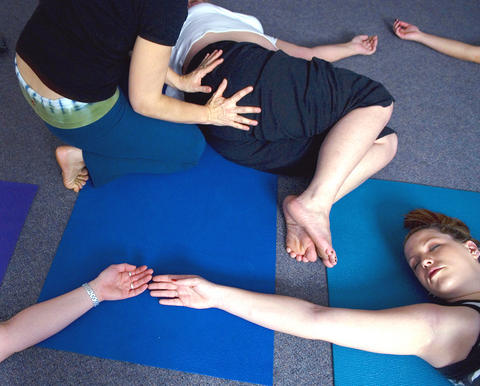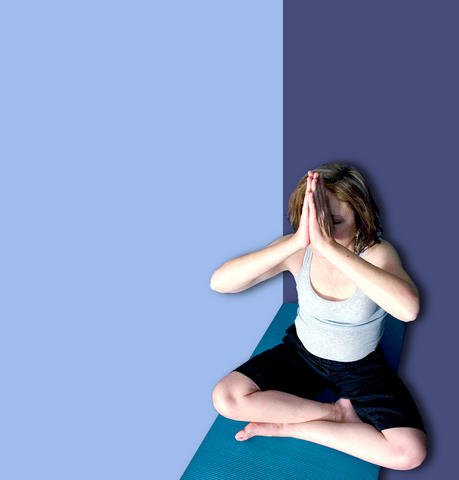Living in a spartan cottage for eight days during a boot camp for aspiring yoga teachers in Hawaii, Sue Jones practiced from 7am to midnight, silently watched the rhythms of the Pacific Ocean from a bluff and, she said, gained the confidence to return to Boston and mend her marriage.
But Jones made another discovery that gnawed at her.
"Everyone had enough money to pay US$4,000 to get to Hawaii," she said, "and I thought, 'Oh, my God, there are 100 people here and thousands of trainings every year, and I don't hear anyone talking about teaching yoga to people who can't afford it.'"

PHOTOS: NY TIMES NEWS SERVICE
After returning to Boston, Massachusetts, Jones started teaching yoga at a substance abuse treatment center. She asked fellow teachers to help and received a flood of responses.
In May 2006, Jones started YogaHope, an organization that teaches yoga at eight Boston-area women's homeless shelters, substance abuse treatment programs and domestic violence safe houses, as well as two programs in Seattle, Washington. The focus is on teaching restorative yoga, and though many teachers have completed at least 200 hours of training, it is not a requirement.
Driven by a missionary-like zeal and a sense that yoga has become an exclusive pursuit, a small but growing number of yoga practitioners are forming organizations that teach yoga in prisons and juvenile detention centers in Seattle; Oakland and Los Angeles, California; and Indianapolis, Indiana. They are working with the addicted and the homeless in Portland, Oregon and with public school students in New York City.

PHOTOS: NY TIMES NEWS SERVICE
Though concern about the cost of yoga is an issue (studio classes can cost US$20 for a drop-in session, though some offer free or low-cost classes taught by less experienced teachers), most of the practitioners are motivated by a desire to introduce yoga to those who might need it most, but wouldn't think to do it on their own.
Jones of YogaHope said she saw a change in the first women she taught after only one class: They held their heads higher, amazed at what their bodies could do. At that moment, she decided to spread yoga to other women. "We're like Christian missionaries," said Jones, a petite blonde whose green eyes flash with emotion as she speaks. "We really want to offer it to people who don't know better or can't access it."
Those who teach or do research on yoga say these programs have increased in recent years as more yoga devotees decide to spread its gospel.
"You can't do all those prostrations without it doing something to you," said James Wvinner, the founder and director of yoga, tribe and culture films for Acacia Lifestyle, a distributor of mind, body and spirit DVDs.
Wvinner, who taught yoga at a federal prison and fondly recalls the sociopath who never missed a class, said more yogis are working in prisons and social service centers.
Others believe bringing yoga to such places harkens to the ancient practice of karma yoga, or the yoga of action and selfless service. "What it speaks to," said Kaitlin Quistgaard, the editor-in-chief of Yoga Journal, "is that social activism is becoming more and more a part of mainstream American yoga. People are realizing it's almost a requirement to give back."
Research in the US on yoga's effectiveness in helping treat drug addiction or mental illness is limited. Most studies have been done on a small scale in India, and the findings aren't universally accepted.
But yoga's function as a stress reliever is not in dispute. "Yoga and meditation do several things, and perhaps one of the most important is that they allow individuals to cope with stress better," said Sat Bir Khalsa, an assistant professor of medicine at Harvard Medical School who studies the medical effects of yoga. "At the core of a lot of addiction is a search for that kind of relief from the stressful world."
Patricia Gerbarg, a clinical assistant professor of psychiatry at New York Medical College, in Valhalla, New York, taught yogic breathing to survivors of the 2004 tsunami in Indonesia, and found that test scores that measure post-traumatic stress disorder, anxiety and depression dropped dramatically.
One recent night at the Volunteers of America Hello House, a residential substance abuse treatment center for women in Boston, about 15 women lunged on their mats, which were squeezed into a common area.
"Tap into your breath to deal with the unknown," said Amanda Richter, a YogaHope teacher. As they moved into the downward dog position, deep breathing filled the room. "Whatever hurts, whatever bad energy you have in your life, you can let it go here," she said.
The women said yoga enabled them to do something that was frightening at first: focus inward. "The teacher always says how you're a good person and to love yourself," said Katey Sullivan, 39. "That makes you feel good about yourself, and you want to stay clean."
That lesson was initially hard for Nikki Meyers. She dabbled with yoga in the 1970s, but soon "men and drugs and sex took priority," she said. In the early 1990s, she got off drugs with the help of a 12-step program and yoga, which she started teaching to children in Boston.
Meyers moved to Indianapolis and opened Cityoga, a studio and health center. Certified under a 500-hour teacher-training program, she also teaches at the Hamilton County Juvenile Services Center outside Indianapolis.
"I tell them that they did movement, breath and a little sitting still for an hour," she said, "and went from irritated and angry to calm and relaxed without taking a drug, without taking a drink, without having alienated your family."
Bidyut Bose, who grew up in India and learned yoga from his father, started teaching it to seniors in 1998 at the Downtown Berkeley YMCA in California. As he saw the students gaining in strength and self-esteem, he started to wonder about others who could benefit. Bose began contacting treatment centers, hospitals and homeless shelters. "If millions of Americans are doing yoga, then there are millions who are not getting it, not coming to a studio, not able to afford classes," he said.
Bose later founded Niroga, an organization in Oakland that teaches yoga to people in drug rehabilitation programs and juvenile detention centers, formerly homeless veterans and victims of domestic abuse. He is also training black youths to become yoga teachers throughout Oakland.
Alex Briscoe, assistant director at the Alameda County Health Care Services Agency, which pays for the yoga classes taught by Niroga and another agency, said that yoga for children has allowed psychiatrists to better treat them.
One hurdle in teaching yoga, especially to teenagers, is debunking ideas that it is a wacky, new age practice. "There's resistance, shyness, embarrassment," said Anne Desmond, who taught yoga at New York City schools and formed Bent on Learning in 2001. The organization, which offers yoga instruction to students and youth centers, teaches at nine schools.
"There's such a transformation," she said, "from this not knowing about yoga and resisting it to really loving it."

We lay transfixed under our blankets as the silhouettes of manta rays temporarily eclipsed the moon above us, and flickers of shadow at our feet revealed smaller fish darting in and out of the shelter of the sunken ship. Unwilling to close our eyes against this magnificent spectacle, we continued to watch, oohing and aahing, until the darkness and the exhaustion of the day’s events finally caught up with us and we fell into a deep slumber. Falling asleep under 1.5 million gallons of seawater in relative comfort was undoubtedly the highlight of the weekend, but the rest of the tour

Youngdoung Tenzin is living history of modern Tibet. The Chinese government on Dec. 22 last year sanctioned him along with 19 other Canadians who were associated with the Canada Tibet Committee and the Uighur Rights Advocacy Project. A former political chair of the Canadian Tibetan Association of Ontario and community outreach manager for the Canada Tibet Committee, he is now a lecturer and researcher in Environmental Chemistry at the University of Toronto. “I was born into a nomadic Tibetan family in Tibet,” he says. “I came to India in 1999, when I was 11. I even met [His Holiness] the 14th the Dalai

Following the rollercoaster ride of 2025, next year is already shaping up to be dramatic. The ongoing constitutional crises and the nine-in-one local elections are already dominating the landscape. The constitutional crises are the ones to lose sleep over. Though much business is still being conducted, crucial items such as next year’s budget, civil servant pensions and the proposed eight-year NT$1.25 trillion (approx US$40 billion) special defense budget are still being contested. There are, however, two glimmers of hope. One is that the legally contested move by five of the eight grand justices on the Constitutional Court’s ad hoc move

Stepping off the busy through-road at Yongan Market Station, lights flashing, horns honking, I turn down a small side street and into the warm embrace of my favorite hole-in-the-wall gem, the Hoi An Banh Mi shop (越南會安麵包), red flags and yellow lanterns waving outside. “Little sister, we were wondering where you’ve been, we haven’t seen you in ages!” the owners call out with a smile. It’s been seven days. The restaurant is run by Huang Jin-chuan (黃錦泉), who is married to a local, and her little sister Eva, who helps out on weekends, having also moved to New Taipei